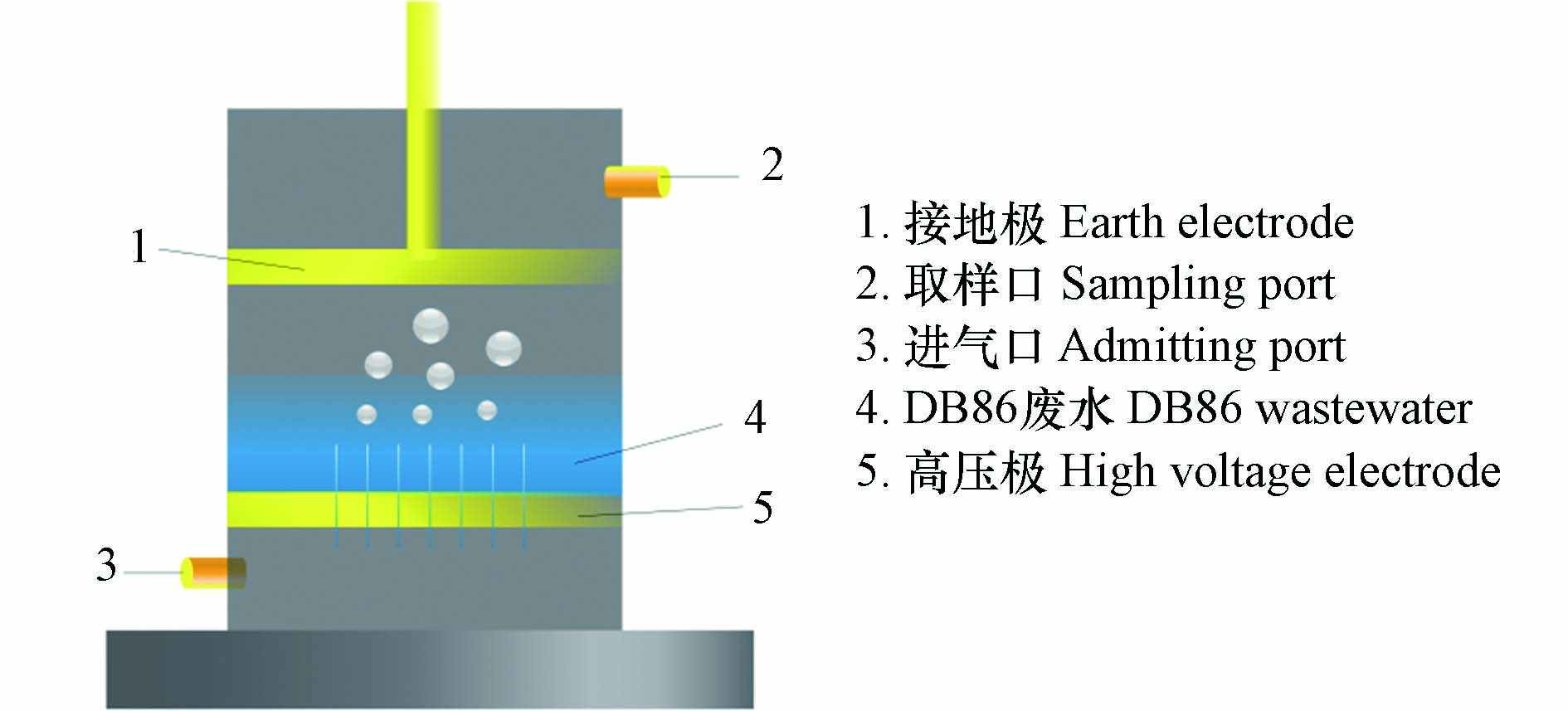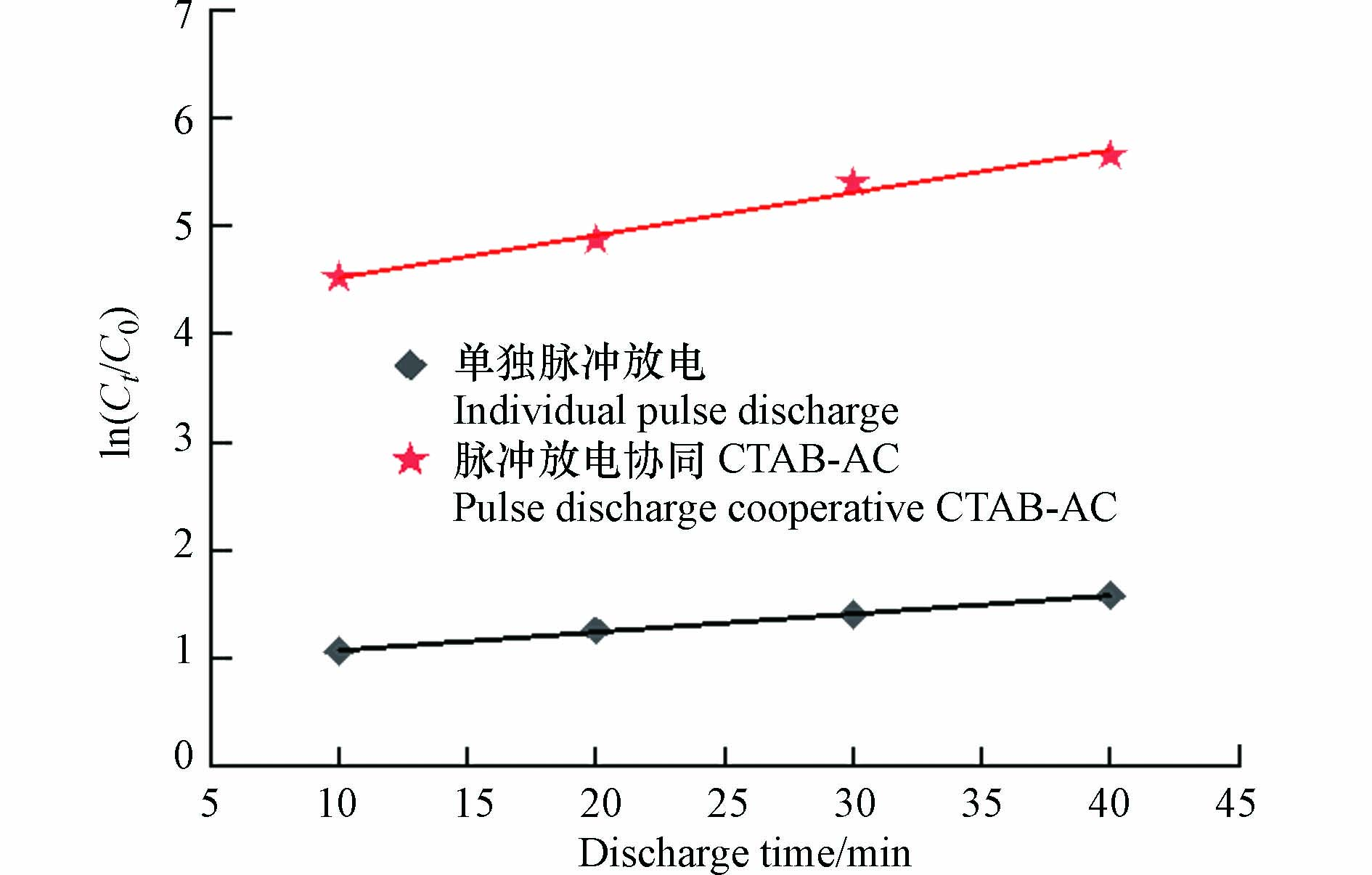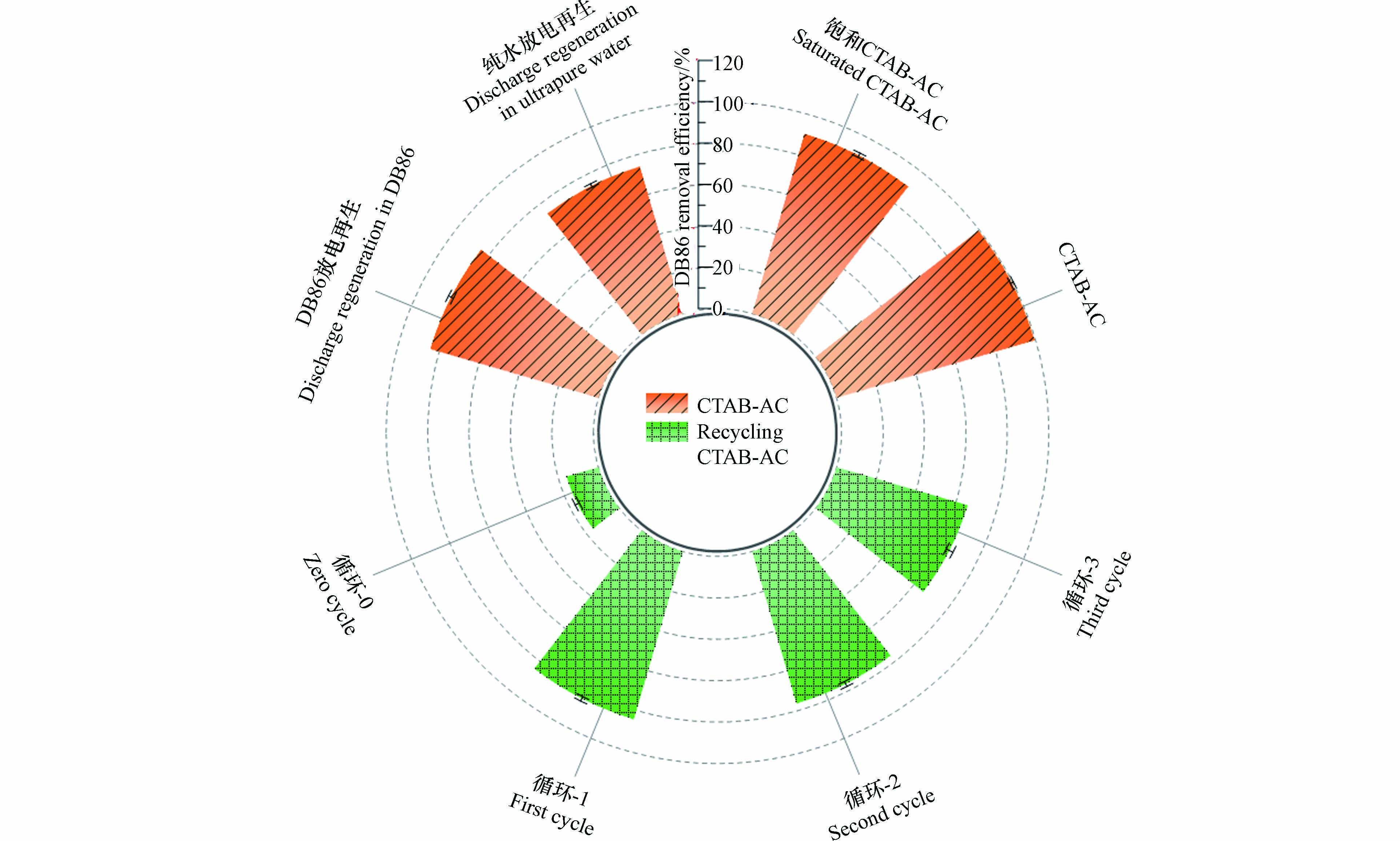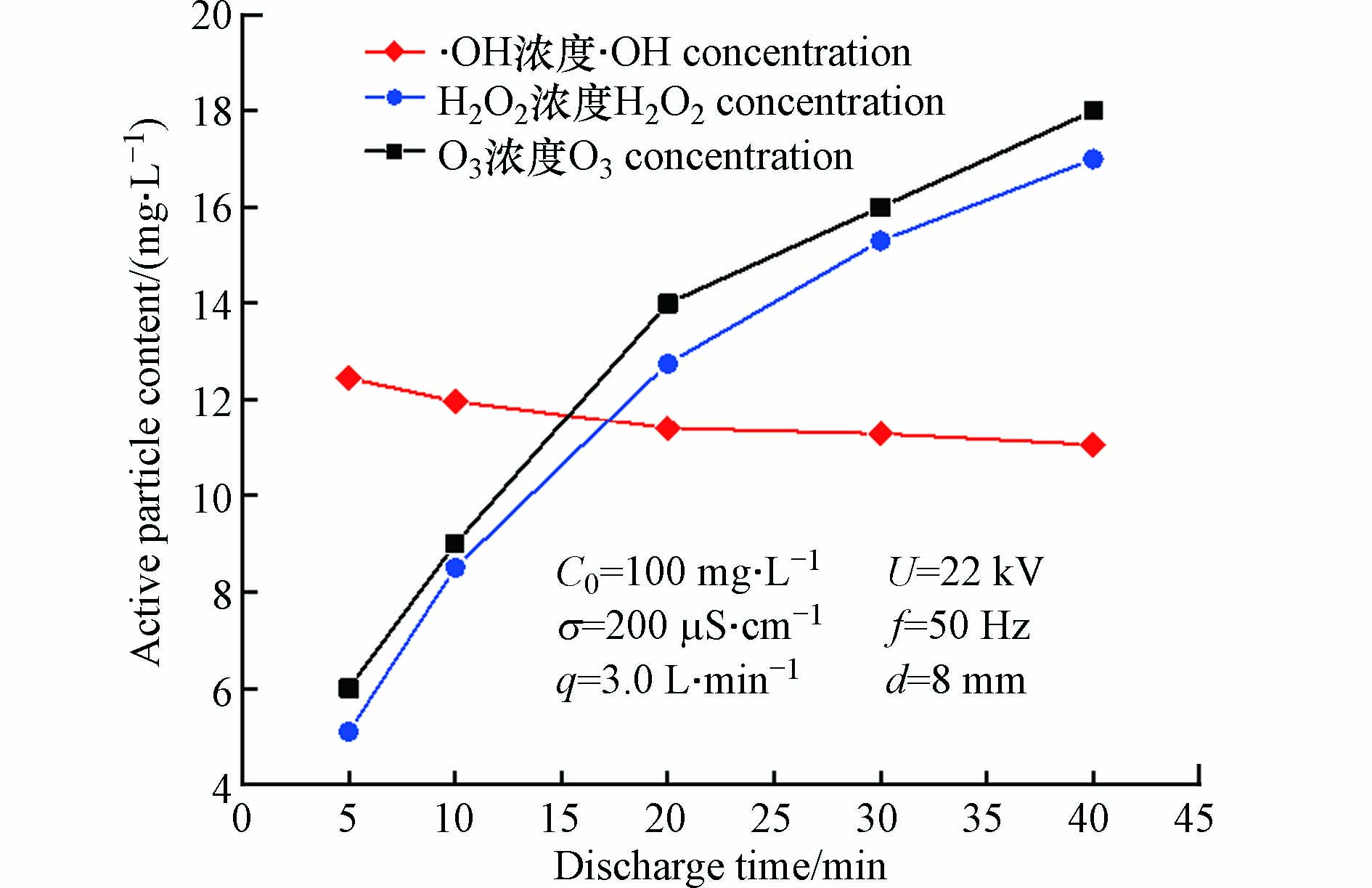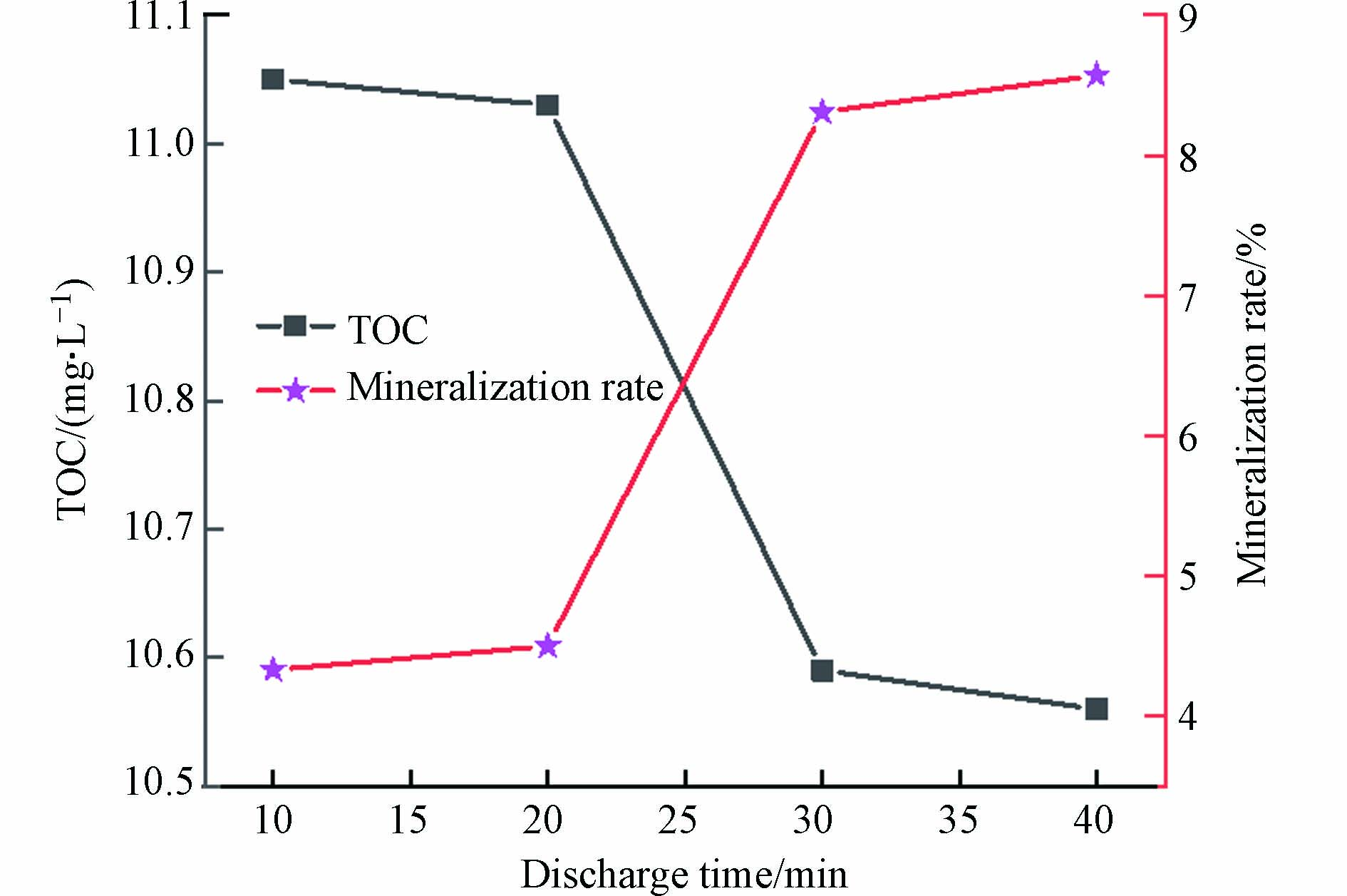-
近年来,以“双碳”目标为战略导向,有序推动产业绿色低碳循环发展已成为全国共识,坚持降碳、减污、扩绿、增长一体化,是染料行业迈向高质量发展的必经之路[1]. 直接耐晒翠蓝GL又称为直接蓝86(Direct Blue 86,DB86),主要用于纺织、印染、皮革、造纸等,是一种典型的直接染料有机污染物[2],大量DB86废水的排放不仅对水体生态造成巨大影响[3-4],其芳香族的性质对人体还有诱变致癌的危害[5-6]. 因此,寻找一种有效去除废水中的DB86具有重要意义. 工业废水传统处理技术,如物理吸附[7]、电化学氧化[8]、生物降解[9]等对DB86的去除虽能起到一定的成效,但大部分存在二次污染等问题. 高压脉冲放电等离子体技术是一项广泛用于处理难降解有机污染物的高级氧化技术,与传统废水处理技术相比其具有高效率、广适用、无二次污染等优势[10-11]. 早在1996年,李胜利等[12]就首次提出利用高压脉冲放电等离子体处理直接蓝2B染料模拟废水,结果表明,该技术能有效破坏染料大分子中的环状结构. 2020年,Rashid等[13]提出水下平行多管等离子射流体系,显著提升了染料废水的可生化性,达到良好的去除效果. 值得注意的是,单独脉冲放电等离子体技术在处理大水量时存在能耗较高的问题. 而催化剂良好的选择性和催化活性,能够提高反应速率,实现节能降耗,也可以抑制反应过程中副产物的转化[14-15]. 因此,脉冲放电协同催化降解有机物技术在近些年发展起来且被认为最有前景的有机废水处理技术之一,它主要将废水中难降解的有机污染物最终转化为小分子化合物、CO2和H2O[16-18].
活性炭(activated carbon, AC)作为一种应用广泛的吸附材料,将等离子体技术与活性炭相结合,可充分利用其吸附和催化的性能[19-20]. AC实用经济,有良好的孔隙结构,富集污染物的同时还可以催化溶液中的O3、H2O2,促进·OH、·O、·HO2等活性粒子的生成[21]. 但其自身的C—C非极性键会降低极性有机污染物的吸附和催化效果[22],为完善AC的品质,本实验用表面活性剂CTAB对AC进行改性处理,以期促进对污染物的去除. 本课题组[23]前期已经在脉冲放电协同催化剂联合处理难降解有机废水上开展了大量实验研究. 在此基础上,为进一步提高DB86的去除效率,采取脉冲放电协同碳催化技术,对CTAB改性活性炭去除DB86进行研究,并运用SEM和BET手段对活性炭改性前后进行表征分析,探讨了DB86初步降解机理,为等离子体协同活性炭去除DB86提供一定的实验理论基础.
-
实验装置系统图如图1所示. 主要由脉冲电源、气流控制、反应器和参数测定4个部分构成. 脉冲电源即高压脉冲电源(P60S-11,大连理工大学静电与特种电源研究所),电压0—60 kV、频率0—200 Hz连续可调,利用鼓气泵(IPX4 ACO-9610,广东海利)和质量流量计(D07系列,北京七星电子)控制气体流量. 放电过程前后采用高效液相色谱(1260 LC,Agilent)测定DB86的浓度;放电过程中利用电流探头(2878,美国Pearson)、电压探头(P6015A,Tektronix)与数字存储示波器(DSO-X-3054A,Agilent)连接,获取实际放电参数. 反应器结构如图2所示,圆筒状,总高140 mm,内径80 mm,高压极是反应器中心均匀分布的7根不锈钢针,每根钢针的针头直径均为1 mm,针头暴露于电极板上部分的长度为10 mm;在前期研究的基础上,确定针与针的间距为2 mm[24];接地极为可调不锈钢板,上下活动不锈钢板可调节两电极之间的间距.
-
催化剂的制备:先后依次用10%NaOH溶液和10%HNO3溶液预处理活性炭,去除活性炭表面的杂质,干燥箱烘干至恒重,即为原始活性炭. 配置CTAB和SDS溶液,对原始活性炭进行改性处理,后放置在恒温干燥箱烘干,得到CTAB-AC和SDS-AC.
CTAB-AC再生实验:称取5 g CTAB-AC加入到100 mg·L−1 DB86溶液中,28 ℃、180 r·min−1恒温振荡器振荡24 h至吸附饱和,过滤后置于105 ℃干燥箱持续6 h,得到饱和的CTAB-AC. 称取定量饱和CTAB-AC,分别在纯水和DB86废水中进行放电实验,洗净再生CTAB-AC,风干后再次投加到DB86溶液中,计算对比此时DB86的去除率.
-
采用 MLA650型场发射扫描电子显微镜(美国FEI公司)对活性炭和CTAB改性活性炭的外观形貌进行表征测试;采用 ASAP2460比表面仪(美国Micromeritics公司)对活性炭和CTAB改性活性炭进行比表面积测试.
-
采用紫外分光光度计(UV754N,上海佑科)对DB86废水全波长扫描,得到DB86的特征吸收峰,本研究选取紫外波长为620 nm. 实验进行中,在高压放电停止的状态下对DB86废水进行取样,利用高效液相色谱对DB86浓度进行分析,并按照下式计算去除率:
其中,
$ \eta $ 表示DB86的去除率(%),$ C_{0} $ 表示DB86的初始浓度(mg·L−1),$ C_{\rm{t}} $ 表示处理一段时间后溶液DB86的浓度(mg·L−1). -
图3依次为未改性AC、CTAB-AC以及饱和CTAB-AC等3种催化剂的SEM表征,展示了3种样品颗粒在放大40 μm的微观形貌. 从图3(a)、(b)可以看出,未改性AC表面光滑平坦,呈鱼鳞块状,层层有序,结构致密. 经浓度5×10−4 mol·L−1CTAB溶液改性后的AC表面变得凹凸不规则,有一些堆积的颗粒附着在AC表面,出现较多凹陷空穴,这是因为CTAB分子利用疏水作用负载在AC表面,而深入活性炭内部的CTAB会改变AC规则的内部结构,形成新的孔隙结构[25]. 由图3(c)可以看出,饱和CTAB-AC结块团聚,有坍塌破裂趋势,粗糙不平,原因可能是大量的CTAB分子被AC吸附至饱和,占据了AC更多的空隙,使得AC的内部结构遭到破坏,甚至失去自身活性. 这表明CTAB浓度过高,会严重破坏AC的微观结构,这一现象与舒世立等[26]的发现相似.
-
未改性AC、CTAB-AC以及饱和CTAB-AC的比表面积测定结果见表1. 未改性AC比表面积为332.98 m2·g−1,经浓度5×10−4 mol·L−1CTAB溶液改性后的CTAB-AC比表面积为9.57 m2·g−1,改性后的AC比表面积仅约为未改性AC的1/30,比表面积的大幅度下降,究其原因一方面可能是AC表面的微孔被CTAB沉积堵塞,表层结构发生变化,另一方面可能是改性后的AC表面上的官能团之间可能存在交联的现象[27-28]. 饱和CTAB-AC的比表面积为77.43 m2·g−1,是CTAB-AC比表面积的7倍有余,可能是大量CTAB分子负载于AC表面,破坏了AC的原始结构,改变AC的表面化学性质,出现颗粒团聚结块不分散现象,使得比表面积比CTAB-AC的大. 结合扫描电镜结果,饱和CTAB-AC可能失去了本身的活性,因此放电实验选用CTAB-AC.
-
采用未改性AC吸附处理DB86废水40 min,DB86的去除率仅为65.36%,为完善活性炭的品质,实验选用十六烷基三甲基溴化铵(CTAB)和十二烷基硫酸钠(SDS)表面活性剂对活性炭进行改性[29]. 对150 mL初始浓度为100 mg·L−1 的DB86溶液,添加0.2 g活性剂改性AC处理40 min,分析比较改性活性炭对DB86的去除效果. 实验结果如图4所示.
由图4可得出,添加相同质量的CTAB-AC和SDS-AC进行去除实验,发现活性剂对AC改性效果显著,改性后AC处理10 min DB86废水就可达到未改性AC处理40 min的成效,且CTAB-AC对DB86的去除效果明显要比SDS-AC的好. 随着处理时间的延长,DB86的去除率均呈上升的趋势,其中SDS-AC的去除效果增长幅度小,40 min后去除率仅从65.85%提高至68.3%,增加不到3%. 而投加CTAB-AC在实验40 min的过程中,DB86的降解率由73.23%提升到78.36%. 此外,在实验初期,两者的作用效果就相差较大,处理40 min后,添加CTAB-AC的DB86去除率仍高于添加SDS-AC的10%. SDS的改性效果更差的原因可能是SDS的临界胶束浓度比CTAB的临界胶束浓度大[30],在相同 DB86浓度下,CTAB能形成更多的聚集体,改善活性炭的亲水性. 因此,后续实验以CTAB为改性剂,研究高压脉冲放电等离子体协同CTAB-AC去除DB86.
-
为进一步考察影响CTAB-AC协同脉冲放电去除DB86的因素,试验对CTAB改性剂浓度、改性时间和改性活性炭加入量进行L9(34)正交试验,溶液初始浓度为100 mg·L−1,放电电压22 kV,初始电导率200 μs·cm−1,放电频率50 Hz,空气流量3.0 L·min−1,电极间距8 mm,正交试验设计和结果分析表见表2 ,其中K1、K2分别表示各因素中3水平所对应DB86去除率的最低水平和最高水平,R为极差. 通过表2正交试验结果分析可得,在不考虑各个因素之间的交互作用的前提下,上述3因素对DB86去除率的影响由强到弱顺序为CTAB改性剂浓度、改性活性炭加入量、改性时间,较佳的改性参数组合为改性剂浓度5×10−4 mol·L−1,改性活性炭投加量0.2 g,改性时间24 h. 为寻求最佳的改性剂浓度,本文着重讨论了CTAB浓度对DB86去除率的影响.
-
为研究CTAB浓度对DB86去除率的影响,在活性炭改性时间8 h,添加 0.2 g的前提下,相同放电条件下放电40 min,设置系列改性剂浓度梯度. 结果如图5所示. 由图5可得出,随着CTAB浓度的不断增大,DB86的去除率也近乎线性递增,效果显著,但达到峰值后有平缓下降的趋势. 当CTAB浓度调整为5×10−4 mol·L−1时,DB86的去除率高达99.65%,而后继续增加CTAB的浓度,污染物的去除率并没有随之增加,反而略微有所减小. 出现这种现象的原因是:改性时间不变,CTAB浓度增大,更多的CTAB分子吸附积聚在活性炭的表面,起到润湿清洗的作用,活性炭表面的孔隙结构更加发达,促进等离子体通道的形成,让DB86与放电产生的活性粒子充分接触;当CTAB浓度过大时,容易使部分活性炭吸附饱和,破坏自身结构,活性降低. 因此,确定最佳CTAB改性浓度为5×10−4 mol·L−1.
-
为研究脉冲放电协同CTAB-AC处理DB86的效果,依次采用单独脉冲放电、单独未改性AC、单独CTAB-AC及放电协同CTAB-AC处理,四大体系对比结果如图6所示. CTAB-AC为最优组合,即改性时间24 h,CTAB浓度5×10−4 mol·L−1,加入量0.2 g,反应时间均为40 min. 由图6可见,单独未改性AC吸附除去DB86的去除率仅为65.36%,单独CTAB-AC体系为78.36%,单独脉冲放电体系为79.30%,而脉冲放电协同CTAB-AC体系中DB86的去除率高达99.65%. 显然,四大体系同时降解DB86,效果最好的是脉冲放电协同CTAB-AC系统. 且脉冲放电协同CTAB-AC比单独未改性AC体系提高了34.29%,比单独CTAB-AC吸附去除提高了21.29%,比单独脉冲放电提高了20.35%. 对比单独AC和单独CTAB-AC吸附处理DB86,发现AC经CTAB改性后,DB86的去除率提高了近15%,可见CTAB改性AC的效果是可观的.
通过绘制单独脉冲放电和脉冲放电协同CTAB-AC两个放电体系中DB86降解的反应速率图,如图7所示,对应拟合程度分析表见表3. 结合图7和表3可知,单独脉冲放电和脉冲放电协同CTAB-AC体系的拟合相关系数 R2分别为0.9976和0.9831,均大于0.97,可以认为在两个放电体系中,DB86的去除过程遵循伪一级反应动力学. 单一脉冲放电体系Kobs值为0.017 min−1,脉冲放电协同CTAB-AC体系Kobs值为0.039 min−1,两者的反应速率常数Kobs相差两倍以上,可以认为CTAB-AC催化剂对脉冲放电体系有促进作用.
-
为研究CTAB-AC催化剂结构的再生性,考察催化剂在去除DB86溶液后回收再利用的催化效果. 采用纯水中放电再生和DB86溶液中放电再生两种再生方式. 分析对比新鲜CTAB-AC、饱和CTAB-AC、纯水放电再生CTAB-AC以及DB86溶液放电再生CTAB-AC四种不同时期的CTAB-AC去除DB86的效果,结果见图8. 由图8可知,饱和CTAB-AC放电催化效果要差于新鲜CTAB-AC放电催化,这与表征结果是一致的. 对比再生效果,CTAB-AC在DB86中放电再生的效果明显好于在纯水中放电的再生效果,且在DB86中放电再生后的去除率超出纯水中放电再生的10%. 出现这种现象的原因是:CTAB-AC的再生受水溶液的电导率的影响,DB86溶液的电导率高于纯水的电导率,故DB86溶液中活性物质在CTAB-AC上的传质效果更好,进而提升了活性物质与饱和CTAB-AC中有机物的接触几率,使CTAB-AC的再生效果更好[30].
对饱和CTAB-AC进行连续3次吸附再生实验,每次放电实验完成后,将实验结束后的CTAB-AC用超纯水冲洗,置于60℃鼓风干燥箱烘干至无水分,并进行下次降解去除实验,循环反复3次,观察 DB86去除率的变化,结果见图8. 由图8结果可以看出,当CTAB-AC吸附饱和时,便会渐渐失去其吸附作用,成为废弃CTAB-AC,而低温等离子体对有机物吸附饱和的活性炭具有再生作用[31]. 经3次循环再生后,DB86的去除率由84.55%降至65.85%,仅降低18.7%. 此外还发现,第三次循环的CTAB-AC的去除率仍高于未处理的废弃CTAB-AC去除率近50%,CTAB-AC经过3次循环后仍有较高的吸附能力. 研究表明[32],普通热再生AC和高温热再生AC热量损耗大,且AC的原子利用率损失5%—8%,利用脉冲放电等离子体再生CTAB-AC,碳损不足1%,可见等离子体再生AC在工业领域中的应用前景广阔.
为考察CTAB-AC催化剂的稳定性,利用CTAB-AC催化剂在去离子水和DB86溶液中进行解吸测试,运用溴酚红光度法[33]测定CTAB浓度,结果详情见表4. 初始CTAB浓度5×10−4 mol·L−1,在去离子水中解吸率为0.63%,平衡浓度为3.17×10−6 mol·L−1;在DB86溶液中CTAB的解吸率为0.54%,平衡浓度为2.71×10−6 mol·L−1. 两种环境下CTAB-AC的解吸测试均达到GB18466-2005中阳离子表面活性剂二级标准(小于5.0 mg·L−1). 因此,利用CTAB对活性炭进行改性是切实可行的,CTAB-AC不会因为解吸作用而成为二次污染隐患源.
-
为研究放电过程DB86溶液的初步降解机理,采用水杨酸、高锰酸钾、碘等对活性粒子进行捕获,测定活性粒子·OH、H2O2及O3浓度变化,浓度变化测定结果见图9.
从图9可以发现,随放电反应的进行,·OH的浓度缓慢降低,说明在放电实验的过程中,体系中开始产生大量的·OH不断被消耗且消耗的速率大于其生成的速率,20 min后达到相对平衡,浓度变化减小. 溶液中H2O2及O3的浓度均逐渐增大,但随着放电时间的增加,H2O2及O3的含量并呈非线性递增,其生成速率越来越小,可见,达到一定的放电时间后,H2O2及O3的浓度将趋于饱和. 而另一方面,随着放电时间的延长,产生的紫外线和冲击波等也越稳定,从而也越容易分解H2O2和O3产生·OH. 表明放电过程中产生的H2O2和O3活性物质并没有与污染物直接反应,而是先转化成·OH间接参与到反应当中. 因此,在脉冲放电协同CTAB-AC催化去除DB86的过程中,·OH起着关键作用.
为研究DB86溶液中TOC的变化,在最佳放电条件下投加0.2 CTAB-AC,放电40 min,分析放电过程中TOC变化规律及矿化规律,结果见图10. 从图10可以看出,DB86溶液的初始TOC值为11.55 mg·L−1,放电40 min后,溶液的TOC值下降到10.59 mg·L−1,矿化率约为8.27%. 随放电时间的延长,DB86溶液的矿化率逐渐提高,尤其在放电20—30 min,矿化率增加迅速,但30 min后增速趋于稳定. 总体而言,矿化程度偏低,TOC值变化不大. 对比相同实验条件下DB86的去除率和矿化率,显然,DB86的去除率要远高于对应时刻的矿化率. 这说明脉冲放电协同CTAB-AC处理DB86废水的过程中,能够产生较多的活性粒子和自由基,促使DB86分子分解转化,但是绝大多数的DB86分子可能转化为小分子化合物或难矿化的中间产物,只有少部分直接转化为CO2和H2O.
-
(1)脉冲放电等离子体协同CTAB-AC催化剂降解DB86表现出良好的促进作用,DB86初始质量浓度为100 mg·L−1,放电电压22 kV,放电频率50 Hz,初始电导率200 μs·cm−1,电极间距8 mm,气体流量3.0 L·min−1,投加0.2 gCTAB改性活性炭,放电40 min,DB86的去除率高达99.65%.
(2)活性炭改性前后的表征技术显示,CTAB活性剂可以改变活性炭的结构和形貌,且通过CTAB改性后的CTAB-AC表面相对粗糙,出现颗粒堆积现象,凹陷空穴增多,增加了反应所需孔道和活性位点,有益于反应的有效进行.
(3)饱和CTAB-AC吸附再生实验表明,脉冲放电对CTAB-AC具有良好的再生作用. 经三次连续循环再生进行放电实验发现,DB86的去除率仍可达65.85%. 此外,CTAB-AC吸附稳定可靠,不会因解吸作用带来二次污染,可行性高,对DB86废水的治理有一定的指导意义.
(4)活性剂种类影响协同处理DB86效果,CTAB活性剂的改性效果优于SDS活性剂. 正交试验表明,3因素对DB86去除的影响强度由低到高依次为改性时间、改性活性炭加入量、CTAB改性剂浓度. 重点考察CTAB改性剂浓度对DB86去除效果发现,随着CTAB浓度的不断增大,DB86的去除率迅速提高,效果显著,达到峰值后有平缓下降的趋势,最佳改性浓度为5×10−4 mol·L−1,DB86在脉冲放电等离子体系中的去除过程符合伪一级动力学方程.
高压脉冲放电等离子体协同CTAB改性活性炭去除DB86
Removal of DB86 by high voltage pulse discharge plasma and ctab modified activated carbon
-
摘要: 印染工业耗水多,同时产生大量色度深、成分复杂的染料废水,制约了相关行业的绿色环保和可持续发展. 实验采用多针-板高压脉冲放电等离子体协同CTAB改性活性炭(CTAB-AC)处理直接耐晒翠蓝GL(Direct Blue 86,DB86)模拟废水. 通过十六烷基三甲基溴化铵(CTAB)对活性炭改性,并利用SEM、BET表征手段对改性前后活性炭进行分析. 考察了CTAB-AC中改性剂浓度、改性时间以及不同投加量对DB86去除效果的影响. 结果显示:在溶液初始浓度C0为100 mg·L−1,频率f为50 Hz,电压U为22 kV,初始电导率σ为200 μs·cm−1,电极间距为8 mm,溶液体积为150 mL,气体流量为3.0 L·min−1,同时添加0.2 g在CTAB浓度为5×10−4 mol·L−1下改性24 h的CTAB-AC,放电40 min后,去除率高达99.65%. 高压脉冲放电对吸附饱和的活性炭具有再生作用,并且经CTAB改性后的活性炭比表面积减小,表面粗糙度增加,凹陷空穴增多,活性位点激增,促进了催化反应,进一步加强了对DB86的去除.Abstract: The printing and dyeing industry consumes a lot of water, and at the same time produces a lot of dye wastewater with deep chroma and complex components, which restricts the green environmental protection and sustainable development of related industries. Multi-needle-plate high-voltage pulse discharge plasma and CTAB modified activated carbon (CTAB-AC) were used to treat simulated wastewater of Direct Blue 86 (DB86). Activated carbon was modified by cetyltrimethyl ammonium bromide (CTAB), and the modified activated carbon was analyzed by SEM and BET. The effects of modifier concentration, modification time and different dosage in CTAB-AC on the removal efficiency of DB86 were investigated. The results show that when the initial concentration of the solution is 100 mg·L−1, the frequency is 50 Hz, the voltage is 22 kV, the initial conductivity is 200 μs·cm−1, the electrode spacing is 8 mm, the solution volume is 150 mL, the gas flow rate is 3.0 L·min−1, and 0.2 g CTAB-AC modified for 24 h at the CTAB of 5×10−4 mol·L−1 is added, the removal rate is as high as 99.65% after 40 minutes of discharge. High-voltage pulse discharge can regenerate saturated activated carbon, and the specific surface area of activated carbon modified by CTAB decreases, the surface roughness increases, the number of depressions and cavities increases, and the number of active sites increases, which promotes the catalytic reaction and further strengthens the removal of DB86.
-
Key words:
- pulse discharge /
- plasma /
- modified activated carbon /
- DB86 /
- removal efficiency /
- environmental
-

-
表 1 不同活性炭的比表面积
Table 1. Specific surface areas of different activated carbons
名称
Name比表面积/(m2·g−1)
Specific surface area未改性AC 332.98 CTAB-AC 9.57 饱和CTAB-AC 77.43 表 2 正交试验设计及结果
Table 2. Orthogonal test design and results
编号
NumberCTAB浓度/(mol·L−1)
CTAB concentration改性时间/h
Modification timeCTAB-AC投加量/g
Dosage of CTAB-ACDB86去除率/%
DB86 removal efficiency1 1×10−4 8 0.1 87.16 2 5×10−4 8 0.2 99.48 3 1×10−3 8 0.3 99.55 4 1×10−4 16 0.1 81.11 5 5×10−4 16 0.3 99.54 6 1×10−3 16 0.2 99.30 7 1×10−4 24 0.3 94.52 8 5×10−4 24 0.2 99.65 9 1×10−3 24 0.1 99.24 K1 87.60 93.32 89.17 K2 99.56 97.80 99.48 R 11.96 4.48 10.31 表 3 不同放电体系中DB86降解反应速率的拟合程度
Table 3. Fitting Degree of DB86 Degradation Reaction Rate in Different Discharge Systems
不同反应体系
Different systemsKobs/(min−1) R2 DB86去除率/%
DB86 removal efficiency单独脉冲放电 0.017 0.9976 79.30 脉冲放电协同CTAB-AC 0.039 0.9831 99.65 表 4 CTAB在去离子水和 DB86溶液中的解吸率
Table 4. Desorption rate of CTAB in deionized water and DB86 solution
CTAB浓度/(mol·L−1) 去离子水中CTAB
CTAB in deionized waterDB86溶液中CTAB
CTAB in DB86 solution平衡浓度/(mol·L−1) 解吸率/% 平衡浓度/(mol·L−1) 解吸率/% 5×10−4 3.17×10−6 0.63 2.71×10−6 0.54 -
[1] 鞠雪敏, 罗莉涛, 张鸿涛, 等. 染料行业废水无害化处理技术现状及发展趋势 [J]. 科技导报, 2021, 39(17): 45-54. doi: 10.3981/j.issn.1000-7857.2021.17.006 JU X M, LUO L T, ZHANG H T, et al. Current situation and development trend of harmless treatment technology for dye wastewater in fine chemical industry [J]. Science & Technology Review, 2021, 39(17): 45-54(in Chinese). doi: 10.3981/j.issn.1000-7857.2021.17.006
[2] RUAN X H, DING N, YANG J X. Dual-level eco-efficiency analysis in sustainable management: An empirical study on textile manufacturers and supply chains in China [J]. Journal of Environmental Management, 2022, 304: 114227. doi: 10.1016/j.jenvman.2021.114227 [3] YASEEN D A, SCHOLZ M. Textile dye wastewater characteristics and constituents of synthetic effluents: A critical review [J]. International Journal of Environmental Science and Technology, 2019, 16(2): 1193-1226. doi: 10.1007/s13762-018-2130-z [4] HASSAAN M A, EL NEMR A, MADKOUR F F. Testing the advanced oxidation processes on the degradation of Direct Blue 86 dye in wastewater [J]. The Egyptian Journal of Aquatic Research, 2017, 43(1): 11-19. doi: 10.1016/j.ejar.2016.09.006 [5] SAMSAMI S, MOHAMADIZANIANI M, SARRAFZADEH M H, et al. Recent advances in the treatment of dye-containing wastewater from textile industries: Overview and perspectives [J]. Process Safety and Environmental Protection, 2020, 143: 138-163. doi: 10.1016/j.psep.2020.05.034 [6] 刘海涛, 丁颖, 徐丽慧, 等. ZIF-8/CdS复合材料对亚甲基蓝的光催化降解 [J]. 环境化学, 2023, 42(1): 288-297. doi: 10.7524/j.issn.0254-6108.2021082903 LIU H T, DING Y, XU L H, et al. Photocatalytic degradation of methylene blue by ZIF-8/CdS composites [J]. Environmental Chemistry, 2023, 42(1): 288-297(in Chinese). doi: 10.7524/j.issn.0254-6108.2021082903
[7] GARG D, MAJUMDER C B, KUMAR S, et al. Removal of Direct Blue-86 dye from aqueous solution using alginate encapsulated activated carbon (PnsAC-alginate) prepared from waste peanut shell [J]. Journal of Environmental Chemical Engineering, 2019, 7(5): 103365. doi: 10.1016/j.jece.2019.103365 [8] KUMAR D, GUPTA S K. Electrochemical oxidation of direct blue 86 dye using MMO coated Ti anode: Modelling, kinetics and degradation pathway [J]. Chemical Engineering and Processing - Process Intensification, 2022, 181: 109127. doi: 10.1016/j.cep.2022.109127 [9] 赵世光, 刘强, 张庆庆, 等. 灵芝漆酶对直接蓝86的催化脱色性能 [J]. 环境工程学报, 2013, 7(2): 765-770. ZHAO S G, LIU Q, ZHANG Q Q, et al. Decolorization of direct bule 86 catalyzed by laccase from Ganoderma lucidum [J]. Chinese Journal of Environmental Engineering, 2013, 7(2): 765-770(in Chinese).
[10] SANITO R C, YOU S J, WANG Y F. Degradation of contaminants in plasma technology: An overview [J]. Journal of Hazardous Materials, 2022, 424: 127390. doi: 10.1016/j.jhazmat.2021.127390 [11] 戴栋, 宁文军, 邵涛. 大气压低温等离子体的研究现状与发展趋势 [J]. 电工技术学报, 2017, 32(20): 1-9. doi: 10.19595/j.cnki.1000-6753.tces.170236 DAI D, NING W J, SHAO T. A review on the state of art and future trends of atmospheric pressure low temperature plasmas [J]. Transactions of China Electrotechnical Society, 2017, 32(20): 1-9(in Chinese). doi: 10.19595/j.cnki.1000-6753.tces.170236
[12] 李胜利, 李劲, 王泽文, 等. 用高压脉冲放电等离子体处理印染废水的研究 [J]. 中国环境科学, 1996, 16(1): 73-76. LI S L, LI J, WANG Z W, et al. Study on treatment of dyeing wastewater by high voltage pulse discharge plasma [J]. China Environmental Science, 1996, 16(1): 73-76(in Chinese).
[13] RASHID M M, CHOWDHURY M, TALUKDER M R. Textile wastewater treatment by underwater parallel-multi-tube air discharge plasma jet [J]. Journal of Environmental Chemical Engineering, 2020, 8(6): 104504. doi: 10.1016/j.jece.2020.104504 [14] 陈向娟, 王欢, 安伟佳, 等. 有机碳材料在光电催化系统中的作用 [J]. 化学进展, 2022, 34(11): 2361-2372. doi: 10.7536/PC220311 CHEN X J, WANG H, AN W J, et al. Study on photoelectrocatalysis of organic carbon materials [J]. Progress in Chemistry, 2022, 34(11): 2361-2372(in Chinese). doi: 10.7536/PC220311
[15] DONG B Y, WANG P X, LI Z D, et al. Degrading hazardous benzohydroxamic acid in the industrial beneficiation wastewater by dielectric barrier discharge reactor [J]. Separation and Purification Technology, 2022, 299: 121644. doi: 10.1016/j.seppur.2022.121644 [16] 陈鹏, 陶雷, 谢怡冰, 等. 低温等离子体协同催化降解挥发性有机物的研究进展 [J]. 化工进展, 2019, 38(9): 4284-4294. doi: 10.16085/j.issn.1000-6613.2018-2485 CHEN P, TAO L, XIE Y B, et al. Non-thermal plasma cooperating catalyst degradation of the volatile organic compounds: A review [J]. Chemical Industry and Engineering Progress, 2019, 38(9): 4284-4294(in Chinese). doi: 10.16085/j.issn.1000-6613.2018-2485
[17] XIE H L, JIN X H. Pulse discharge plasma coupled with magnetic mesoporous silica for synergistic degradation of pharmaceutical wastewater and mechanism [J]. Journal of Environmental Chemical Engineering, 2022, 10(1): 106815. doi: 10.1016/j.jece.2021.106815 [18] LI X, WANG T C, QU G Z, et al. Enhanced degradation of azo dye in wastewater by pulsed discharge plasma coupled with MWCNTs-TiO2/γ-Al2O3 composite photocatalyst [J]. Journal of Environmental Management, 2016, 172: 186-192. [19] GUO H, WANG H J, JIA Y Y, et al. Study on emission spectrum of OH radicals in a combination system of pulsed discharge plasma and activated carbon [J]. Guang Pu Xue Yu Guang Pu Fen Xi = Guang Pu, 2016, 36(12): 4135-4140. [20] 马可可, 周律, 白昱, 等. 低温等离子体协同催化氧化水处理技术的研究进展[J]. 应用化工, 2021, 50(10): 2775-2779, 2785. MA K K, ZHOU L, BAI Y, et al. Research progress on low-temperature plasma combined with catalytic oxidation technology for water treatment[J]. Applied Chemical Industry, 2021, 50(10): 2775-2779, 2785 (in Chinese). [21] 王慧娟, 郭贺, 杨文明, 等. 脉冲放电等离子体/活性炭协同降解染料废水及过氧化氢的生成 [J]. 高电压技术, 2016, 42(5): 1401-1408. WANG H J, GUO H, YANG W M, et al. Formation of hydrogen peroxide and degradation of dye wastewater by pulsed discharge plasma combined with activated carbon [J]. High Voltage Engineering, 2016, 42(5): 1401-1408(in Chinese).
[22] 侯博, 陈思铭, 江波, 等. 活性炭吸附挥发性有机化合物的研究进展 [J]. 安全与环境工程, 2021, 28(1): 197-208. HOU B, CHEN S M, JIANG B, et al. Research progress of adsorption of volatile organic compounds by activated carbon [J]. Safety and Environmental Engineering, 2021, 28(1): 197-208(in Chinese).
[23] 董冰岩, 李贞栋, 王佩祥, 等. 脉冲气液两相放电等离子体耦合Fe改性的TiO2催化剂降解废水中的4-氯酚 [J]. 化工进展, 2021, 40(12): 6721-6728. DONG B Y, LI Z D, WANG P X, et al. 4-Chlorophenol containing wastewater joint treated by pulsed discharge plasma in gas-liquid two phase and Fe-modified TiO2 catalyst [J]. Chemical Industry and Engineering Progress, 2021, 40(12): 6721-6728(in Chinese).
[24] 董冰岩, 李琼, 王慧, 等. 高压脉冲放电降解选矿废水中残余黄药的研究 [J]. 现代化工, 2019, 39(9): 87-91. DONG B Y, LI Q, WANG H, et al. Study on degradation of residual xanthate in mineral separation wastewater by high voltage pulse discharge [J]. Modern Chemical Industry, 2019, 39(9): 87-91(in Chinese).
[25] 孟筠青, 王丽娟, 王顾儒, 等. 表面活性剂对硅尘润湿性影响的分子模拟研究[J]. 安全与环境学报, 2022: 1-7. MENG J Q, WANG L J, WANG G R, et al. Molecular simulation of the influence of surfactants on the wettability of silicon dust[J]. Journal of Safety and Environment, 2022: 1-7 (in Chinese).
[26] 舒世立, 和芹, 王磊, 等. 十六烷基三甲基溴化铵改性活性炭的制备及吸附苯酚研究 [J]. 化学世界, 2018, 59(12): 801-808. SHU S L, HE Q, WANG L, et al. Preparation of activated carbon modified by hexadecyl trimethyl ammonium bromide and its adsorption of phenol [J]. Chemical World, 2018, 59(12): 801-808(in Chinese).
[27] 刘江龙, 郭焱, 席艺慧. FeCl3和十六烷基三甲基溴化铵改性赤泥对水中铜离子的吸附性能和机理 [J]. 化工进展, 2020, 39(2): 776-789. LIU J L, GUO Y, XI Y H. Adsorption and mechanism of copper ions in water by red mud modified with FeCl3 and hexadecyl trimethyl ammonium bromide (CTAB) [J]. Chemical Industry and Engineering Progress, 2020, 39(2): 776-789(in Chinese).
[28] VUKOVIĆ G D, MARINKOVIĆ A D, ČOLIĆ M, et al. Removal of cadmium from aqueous solutions by oxidized and ethylenediamine-functionalized multi-walled carbon nanotubes [J]. Chemical Engineering Journal, 2010, 157(1): 238-248. doi: 10.1016/j.cej.2009.11.026 [29] 朱留凯, 昌莹鸽, 种元辉, 等. 生物质活性炭的改性方法研究进展 [J]. 应用化工, 2021, 50(7): 1900-1904. doi: 10.3969/j.issn.1671-3206.2021.07.035 ZHU L K, CHANG Y G, CHONG Y H, et al. Research progress in modification methods of biochar [J]. Applied Chemical Industry, 2021, 50(7): 1900-1904(in Chinese). doi: 10.3969/j.issn.1671-3206.2021.07.035
[30] 杨鹤群, 韩春蕊, 赵丹青, 等. 无患子皂素的表面活性及复配增效性能 [J]. 化工进展, 2015, 34(12): 4343-4347,4355. YANG H Q, HAN C R, ZHAO D Q, et al. Surface activity and commixture synergism property of Sapindus mukurossi saponin [J]. Chemical Industry and Engineering Progress, 2015, 34(12): 4343-4347,4355(in Chinese).
[31] 储金宇, 刘永杰, 王慧娟, 等. 脉冲放电等离子体再生吸附AO7饱和活性碳 [J]. 高电压技术, 2015, 41(1): 251-256. CHU J Y, LIU Y J, WANG H J, et al. Regeneration of acid orange 7-exhausted granular activated carbon with pulsed discharge plasma [J]. High Voltage Engineering, 2015, 41(1): 251-256(in Chinese).
[32] 屈广周, 李杰, 鲁娜, 等. 活性炭吸附-介质阻挡放电等离子体处理五氯酚 [J]. 环境化学, 2010, 29(1): 96-99. QU G Z, LI J, LU N, et al. Activated carbon adsorption/dielectric barrier discharge plasma for treatment of pentachlorophenol [J]. Environmental Chemistry, 2010, 29(1): 96-99(in Chinese).
[33] 黄传敬. 阳离子表面活性剂与溴酚红的显色反应及其分析应用 [J]. 光谱学与光谱分析, 2000, 20(2): 252-255. HUANG C J. Color reaction of cationic surfactants on bromphenol red and its analytical applications [J]. Spectroscopy and Spectral Analysis, 2000, 20(2): 252-255(in Chinese).
-



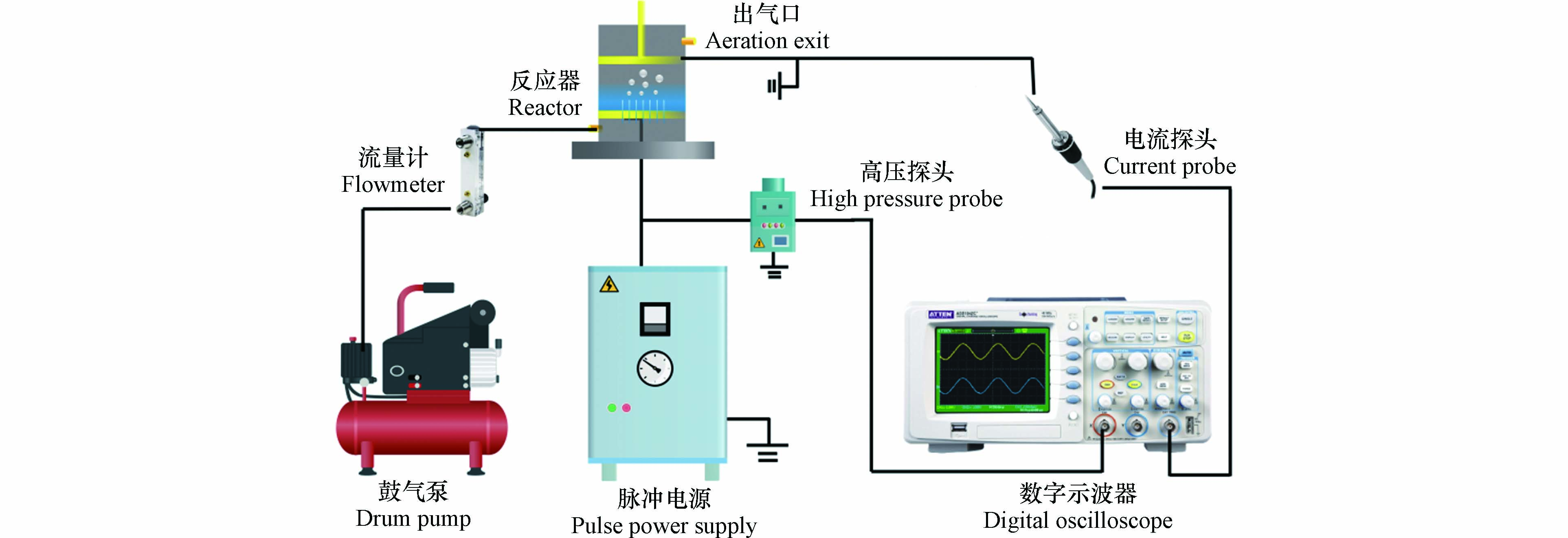
 下载:
下载:
